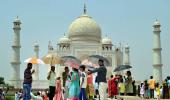The probability of temperatures soaring to 40 degrees Celsius around the festival of Holi late March has multiplied due to climate change, according to an analysis of temperature data since 1970.

Researchers at the US-based Climate Central, an independent group of scientists, conducted the analysis to place India within the context of global warming trends.
In the climate of the early 1970s, it would be exceedingly rare to encounter temperatures in late March above 40 degrees Celsius.
Maharashtra, Chhattisgarh and Bihar had a more than 5 percent chance of experiencing such temperatures, they said.
However, the analysis revealed that the chance of reaching 40 degrees Celsius has since expanded to include nine states: Maharashtra, Chhattisgarh, Bihar, Rajasthan, Gujarat, Telangana, Madhya Pradesh, Odisha and Andhra Pradesh.
Maharashtra now has the highest probability at 14 percent.
To show this change, the researchers calculated the difference between the warming rates in March and April, expressed as the change in average temperature since 1970.
The researchers said a total of 37 cities now have at least a 1 percent chance of experiencing 40 degrees Celsius or warmer temperatures, and 11 cities have a 10 percent or greater probability.
With the exception of Madurai, the 15 cities with the highest risk of experiencing temperatures above 4 degrees Celsius are in central India, the analysis showed.
Bilaspur faces the highest risk at 31 percent, and its chances of reaching 40 degrees Celsius is now 2.5 times higher than in the 1970s.
Indore shows the largest change in risk, with an 8 percent probability, 8.1 times higher than in the past.
Madurai and Bhopal also have very large changes (7.1 and 5.5 times higher, respectively) and relatively high overall risk (19 percent and 12 percent).
Climate Central said March and April are warming across India.
Every region considered had net warming during both March and April.
During March, the northern and western regions have the fastest warming, with the largest change since 1970 in March occurring in Jammu and Kashmir (2.8 degrees Celsius).
Warming is more uniform in April and Mizoram has the largest change since 1970 (1.9 degrees Celsius).
"There has been an abrupt transition in the temperatures from cool winter-like temperatures to much warmer conditions now. After the strong warming trend observed in February, March is also likely to follow the same pattern. These warming trends in India are a clear sign of the impacts of human-led climate change," said Andrew Pershing, VP for Science, Climate Central.
The independent group of scientists and communicators previously said that winters are quickly transitioning into summer-like conditions in north India, shortening the spring season.
The average temperatures in states in north India showed either a cooling trend or slight warming in January, followed by strong warming in February.
This indicates that these regions are now experiencing abrupt transitions from cool winter-like temperatures into much warmer conditions traditionally observed in March, the researchers said.
Mahesh Palawat, vice president -- meteorology and climate change, Skymet Weather, said, "There is no denying the fact that climate change is behind the soaring mercury levels. Heatwaves in March were rare but with the increasing global warming, the probability of heatwaves or high temperatures has increased. We will witness similar weather conditions this year as well. This trend will continue in the coming days and we must prepare for an intense summer season ahead."
Global average temperatures have risen by more than 1.1 degrees Celsius since 1850, exacerbating climate impacts, with 2023 being the hottest on record.
According to the World Meteorological Organisation's State of the Global Climate 2023 report, Greenhouse gas levels, surface temperatures, ocean heat and acidification, and sea level rise all reached record highs in 2023.
The greenhouse gases spewed into the atmosphere, largely due to the burning of fossil fuels since the start of the Industrial Revolution, is closely tied to it.
Climate science says the world needs to slash CO2 emissions by 43 percent by 2030 to limit the average temperature rise to 1.5 degrees Celsius, the guardrail to prevent worsening of climate impacts.
The business-as-usual scenario will take the world to a temperature rise of around 3 degrees Celsius by the end of the century, scientists have warned.










